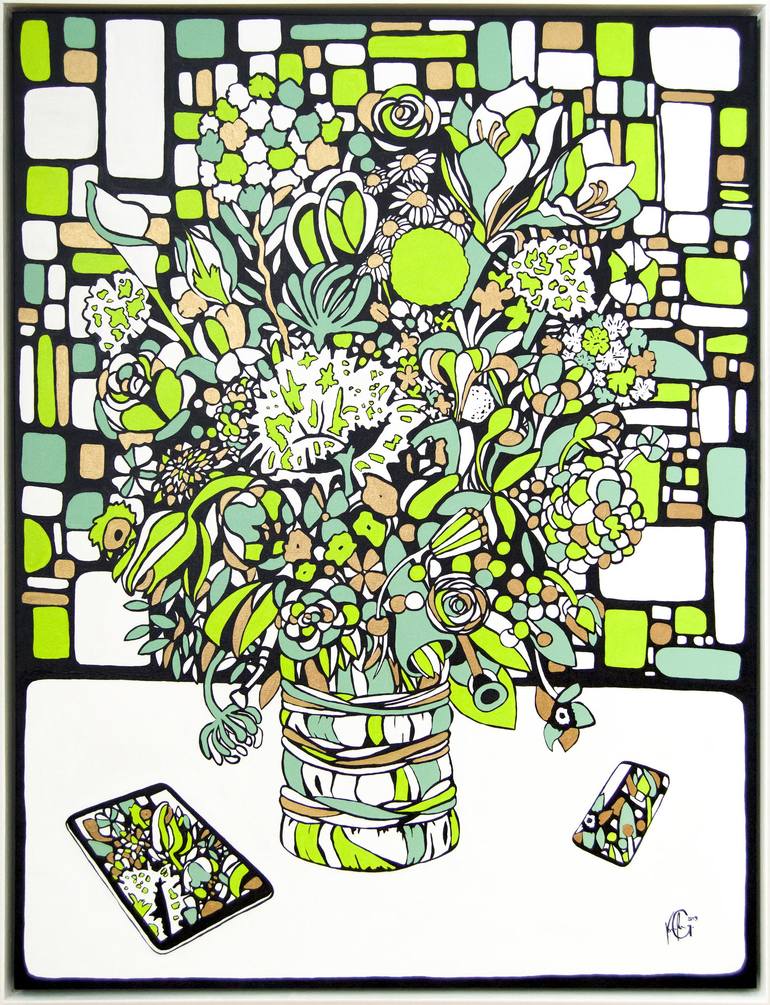






VIEW IN MY ROOM
Still Life Painting
Germany
Painting, Acrylic on Canvas
Size: 31.5 W x 39.4 H x 1.6 D in
Ships in a Box
Artist Recognition

Artist featured in a collection
About The Artwork
The graphic acrylic painting "Still Life" combines the tradition of the classical still life with our modern present. The large bouquet of flowers as an immobile composition appears before the viewer in bright green tones. As aesthetically immovable as the flowers are in the painting, they are transient in their form of existence. In the symbolic sense of vanitas they stand for transience. The flowers have a certain lifetime at their disposal. The climax of their beauty is captured in the still life. The same aspect applies to the lower half of the painting. On the table are two objects typical of everyday life for the contemporary observer: on the right lies a smartphone, on the left a tablet. On their surface is the mirror image of flowers, which in the art history of still life stands for immortalization and identical reproduction of reality. At first glance, the technical objects as inanimate things appear to have nothing to do with the idea of vanity. But just like withering flowers, they reach a man-made expiration date. With the progress of technology and digitalisation, they too will be replaced by new objects in the future.
Details & Dimensions
Painting:Acrylic on Canvas
Original:One-of-a-kind Artwork
Size:31.5 W x 39.4 H x 1.6 D in
Frame:White
Ready to Hang:Not applicable
Packaging:Ships in a Box
Shipping & Returns
Delivery Time:Typically 5-7 business days for domestic shipments, 10-14 business days for international shipments.
Handling:Ships in a box. Artists are responsible for packaging and adhering to Saatchi Art’s packaging guidelines.
Ships From:Germany.
Customs:Shipments from Germany may experience delays due to country's regulations for exporting valuable artworks.
Have additional questions?
Please visit our help section or contact us.
Germany
Veronika Spleiss (born 1993) is a painter of hidden object canvases with their own philosophical stories. "The viewer seems to get lost in the overabundance of details in her paintings, which are located somewhere between comic and Kandinsky", as Jürgen Moises of the Süddeutsche Zeitung writes. The artist often uses abstract and geometric forms. Her painting palette resembles a rush of colour tones full of expressiveness, which in turn seem reduced within a work of art. With the colour and form described, her artworks show a confusion that makes us aware of the tension and diversity of life between order and chaos. Philosophically, the painter tries to take a look at all perspectives of everyday life. Veronika Spleiss is represented by renowned art galleries such as Galerie Klose, Grüne Zitadelle, singulart, and justBEE. Her "Wimmelbilder" can be found in private collections all over the world: in Japan, France, Switzerland, Germany, Austria and the USA.
Artist Recognition

Artist featured by Saatchi Art in a collection
Thousands Of Five-Star Reviews
We deliver world-class customer service to all of our art buyers.
Global Selection
Explore an unparalleled artwork selection by artists from around the world.
Satisfaction Guaranteed
Our 14-day satisfaction guarantee allows you to buy with confidence.
Support An Artist With Every Purchase
We pay our artists more on every sale than other galleries.
Need More Help?